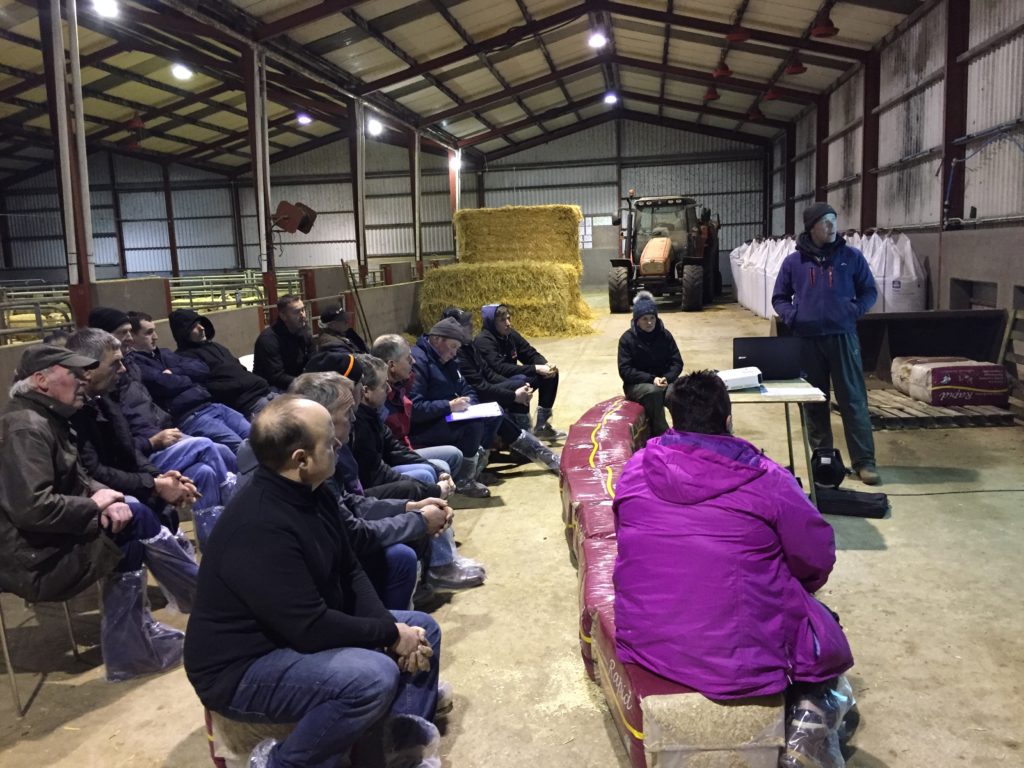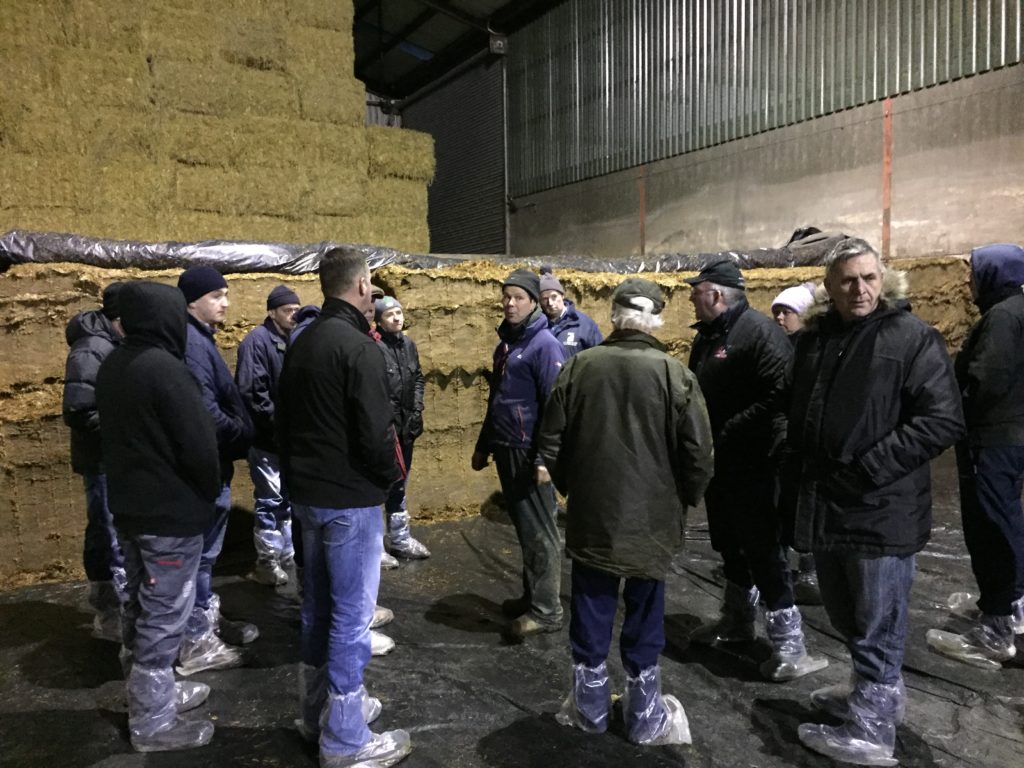Attention to detail is crucial to the success of the sheep enterprise
March 31, 2020
Rachel Megarrell, CAFRE Beef & Sheep Development Adviser
Prior to the outbreak of Covid – 19 the North Antrim Sheep Business Development Group (BDG) ended their programme of events for the year with a visit to the farm of Roger and Hilary Bell, Kells.
The Bells farm 150 acres plus conacre stocked with 550 ewes and approximately 40 store cattle purchased annually for finishing. The day to day running of the farm is largely managed by Hilary while Roger is off-farm with his contracting business.

Roger Bell welcomes members of the North Antrim Sheep Business Development Group to his farm
At the heart of the business is the drive to increase and improve efficiency to maximise kg of liveweight produced/Hectare. Physical performance of the flock is excellent with this year’s scanning results in excess of 200%. Surplus lambs are removed immediately and reared on an automatic feeder.
Use of EID and the integration of technology on the farm is continually increasing and is seen as an important aid to flock management. Collection of data within the sheep enterprise begins at tupping time with the use of EID technology to group ewes and assign a ram to that batch. At lambing, lambs are tagged at birth and a record is made of weight, sex, date of birth and the maternal characteristics of the dam such as lambing ease, mothering ability and milk supply are recorded. This information is subsequently used to make informed management decisions around the selection of replacements.
In the lead up to lambing the flock are scanned, separated into groups of singles, twins and triplets and are housed in a purpose built lambing shed. Initially the ewes are offered a silage only diet with additional protein included in the diet closer to lambing. In recent years the feeding regime for the flock has changed completely. The use of protected soya has been introduced in the form of Sopralin and this is fed to the ewes via a total mixed ration (TMR). The success of this diet relies heavily on the production of excellent quality silage to meet both the ME and protein requirements of the pregnant ewe. Feeding must be precise and there will be 4 different mixes through the wagon which allows the diet formulation to be changed for specific groups. With the use of protected soya in the diet the feed cost/ewe in the enterprise has reduced significantly. After lambing ewes are not offered any concentrate feed as grass is managed on the farm to a high standard to meet the needs of the lactating ewe.

Group members discuss the importance of attention to detail in silo management to optimise fermentation and reduce waste
Grassland management on the farm is critical and grass growth is measured and recorded weekly using a plate meter. 1st cut silage in 2019 was harvested on 5th May and this paid dividends as the analysis of this silage was excellent with an ME in excess of 12 (MJ/kg), a D Value of 77% and a Crude Protein content of 16%. The farm itself is challenging to manage as the land is made up predominantly of heavy soil and in parts runs to 240m above sea level. Measures in place to optimise grass production include soil sampling on a yearly basis which allows soil needs to be met appropriately. A reseeding plan is in place and pH monitored to ensure grass production is maximised. Fertiliser is applied using a quadbike and sower to help prevent compaction and allows access to heavier land earlier in the season. Days to sow are carefully chosen with due regard paid to both weather and ground conditions.
A robust health plan is in place on the farm for both ewes and lambs, ewes are blood tested three times a year to provide a metabolic profile which allows any deficiencies to be appropriately addressed. Lambs are dosed according to Faecal Egg Count (FEC) results which are taken before and after treatment to monitor resistance levels. This analysis is now carried out on farm following investment in the FecPak G2 machine. Roger admits that it is fluke that causes a real issue on the farm and therefore a rigorous programme for fluke treatment is in place.
Lambs are weighed every 1-2 weeks throughout the season to ensure that they meet optimum market specification as they go direct to slaughter. This is done via an electronic weighbridge with the facility to shed lambs off.
Benchmarking is also completed not only to allow comparison of the sheep enterprise with other producers but also to review individual performance year on year. Measure to manage was a key message throughout the visit and innovation and continual improvement are common themes within this business. Peer learning is just one of the advantages of being a part of the Business Development Group scheme and enables members to have the opportunity to visit and appraise similar farm systems.
The Bells farm is one of the new recently selected Technology Demonstration Farms (TDFs) focusing on grassland management that CAFRE has appointed. Hopefully later in the year other farmers will have the opportunity to visit the farm to see some of the technology in operation.
The Business Development Groups Scheme is part of the NI Rural Development Programme and is part funded by the European Agricultural Fund for Rural Development.
